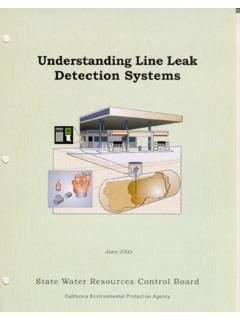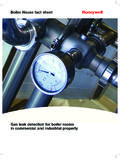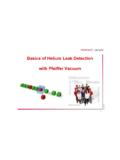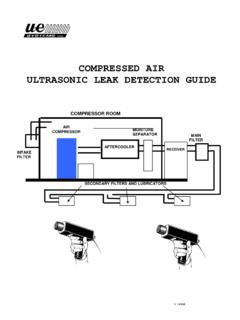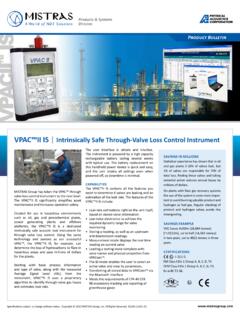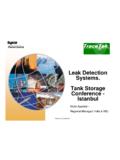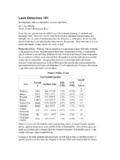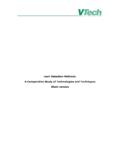Transcription of D352408X012 - Best Practices in Leak and Theft …
1 White PaperApril 2016D352408X012 AbstractIn the Oil & Gas pipeline leak detection market today, there are several software based methodologies available ranging from simplistic pressure wave methods, to real-time model-based volume balance techniques. All approaches have inherent advantages and disadvantages, defi nable in terms of simplicity of implementation/maintenance needs, reliability, cost, robustness, availability, and accuracy (minimum leak size and location). It is a fact that no one methodology can lay claim to be able to satisfy all the advantages over all operating regimes and so the choice of a leak or Theft detection system must be based on a clear user defi ned set of objectives. This white paper aims to bring some clarity to the various leak and/or Theft detection methodologies available today.
2 It specifi cally highlights the fundamentals for achieving the best leak detection system and for each method; it considers the advantages, the disadvantages, and the applicability of that method for particular pipeline characteristics with particular hydraulic ability to detect leaks accidental or planned ( Theft ) on liquid and gas pipelines continues to be a subject for debate and the focus on leak detection has recently intensifi ed. This is a result of high profi le litigation, the increasing frequency of product Theft and the continual drive for improved safety and environmental paper focuses on software based leak and Theft detection as one of the detection technologies with the best cost-benefi t ratio when based on instrumentation and data acquisition already required for operation of the Practices in Leak and Theft DetectionMidstream Oil and Gas 2016 Emerson have been working in the area of leak and Theft detection and location since the 1970 s and have built an extensive level of experience through the implementation of over 300 of its live installations and resulting in a combination of good and bad experiences.
3 It is fi rmly believed by the company that practical experience of the real life implementation of leak and Theft detection systems is the only true qualifi cation for being able to provide an accurate assessment for what can be achieved with the technologies available today. There is a wealth of material available in today s market that claims an independent consideration of available technology but all too often this material culminates in the form of biased hypothetical reports supported only with theoretical assessment or tests under ideal fundamental requirement for a leak or Theft detection system is that it is able to detect leaks with limited false alarms. Too many false alarms and the system will be rendered practically useless. The system must also be able to cope with all operating conditions with minimal desensitization of the leak detection capability.
4 Minimal desensitization is actually the diffi cult part. Unfortunately, many leak detection system vendors will claim that their particular solution can cope with all operating conditions without any loss of performance and this ultimately leads to disillusionment with the industry when this can not be frequently want a system installed with minimal interference and without the need to provide signifi cant amounts of data, they want high sensitivity, no false alarms, operation without attention and no continuing maintenance costs. This should also be across all operating conditions. The industry has been too willing to promise all the good features and avoid mentioning the pitfalls, to the extent that there is skepticism about the existence of practical leak detection systems in the market.
5 Emerson are acutely aware of this problem and will continue to actively take steps to correct following describes the step-by-step process for ensuring that a leak detection system has its greatest chance of achieving satisfactory Challenge of Leak and Theft detection and LocationLet s start by outlining some typical relations between leak size and location whether accidental or intentional ( Theft ). A typical expectation of a leak detection system is to detect a leak of 1% of the normal fl ow rate and locate it within say one hundred meters but what does that actually approximate terms, a leak of 1% of the current fl ow rate changes the pressure drop in the pipeline by anything between 0 and 2% depending on the location of the leak, and creates a fl ow imbalance of approximately 1% of the fl ow rate.
6 Compared to typically specifi ed measurement accuracy s of , it seems to be a fairly simple task to detect the changes due to the leak , the stated changes shall now be compared to the following typical operational variations and uncertainties:a. a fl ow change of creates a change in pressure drop change of 1%b. a density uncertainty of 1% also creates a pressure drop uncertainty of 1%c. a pump easily generates pressure oscillations in the order of 3-5% of the pressure dropd. a tank change easily creates a pressure change of the same magnitudeIn terms of leak location it shall be remembered that moving the 1% leak 10% of the distance between pressure measurements, only creates a change in pressure drop of less than In other words, even if the impact of the leak is signifi cant compared to the meter accuracy it is often very small compared to even small operational changes and uncertainties.
7 For leak location it is especially critical as even very small measurement errors or other uncertainties can destroy the leak location capability if not managed properly. Even under ideal conditions, it can be extremely diffi cult to locate small leaks within a 100 meters, as this will require a maximum distance between pressure instruments of 5 -10 km and a sampling rate and a maximum time skew of Oil and Gas SolutionsApril 2016 These numbers should illustrate why leak detection and location is not only a question of looking for pressure changes and fl ow imbalances in a time series of pressures and fl ow impact of a leak is generally proportional to the leak size, so it should be equally obvious that the diffi cult part of leak detection and location is related to the detection of very small leaks.
8 This also means that the total cost of detecting leaks increases with the need to detect smaller leaks with better location methodologies discussed in this paper are in general limited to leak sizes of the order of 2 times the accuracy of the fl ow meters, and the location capability is in general limited to 5 to 10 % of the distance between accurately calibrated pressure instruments when considering leaks below 1%.Ensure that the instrumentation gives the leak detection system its greatest chance of successMost software based leak detection systems utilize existing fl ow and pressure instrumentation that has been installed for controlling the pipelines operation. Unfortunately this instrumentation has most likely not been installed with a leak detection application in mind.
9 The leak detection system installed is then all too frequently expected to overcome instrument defi ciencies without loss of performance and that is the fi rst step on the path of disillusionment with the leak detection system. Regardless of the methodology selected, it stands to reason that leak detection based on instrumentation will always be highly infl uenced by the performance of the instrumentation course there will be different approaches for dealing with poor instrument performance and some approaches may recover from poor instrument performance faster than others may but without exception, poor instrumentation is at the expense of capability. Accurate, repeatable and available, correctly positioned instrumentation is required to maximize leak detection performance.
10 It should then be accepted that any defi ciencies in the instrumentation will ultimately lead to a reduced capability, whether in terms of minimum detectable leak size, accuracy of leak location, time to detect, number of false alarms or leak detection availability (a component of performance frequently overlooked).Review and ensure the necessary data acquisition performanceThere is little benefi t in maximizing the instrumentation performance if the data acquisition system cannot maintain and transfer the information to the same level of a measurement is specifi ed to a given accuracy then the data acquisition must be able to transfer data to at least the same level of accuracy as provided by the instrumentation. For example, a pressure measurement accurate to of a 100 bar range means that it is accurate to bar.











